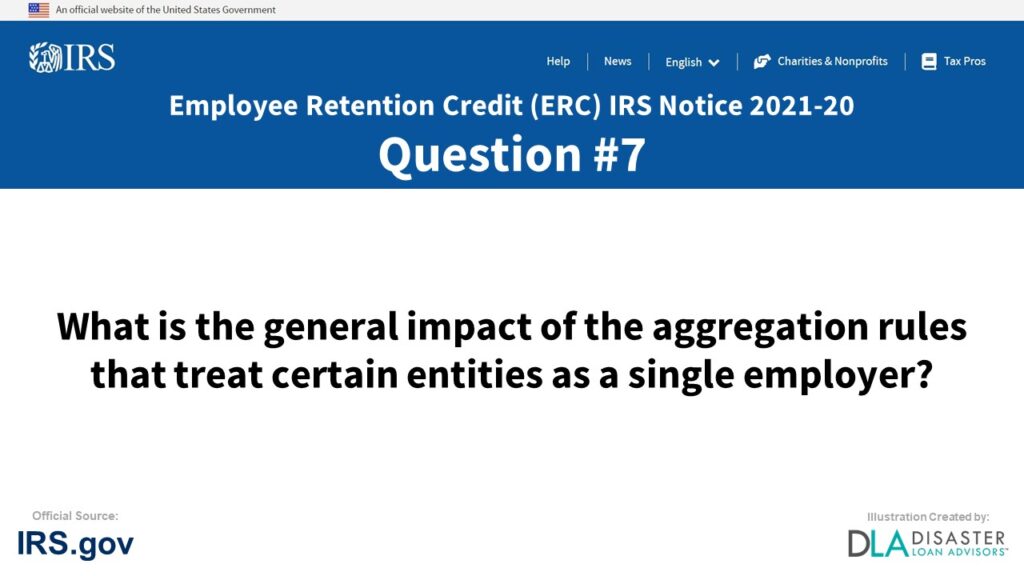
Question #7:
What is the general impact of the aggregation rules that treat certain entities as a single employer?
Found under the B. Aggregation Rules section of the Employee Retention Credit (ERC) IRS Notice 2021-20 with updated guidance to help business owners follow the current ERC rules.
The answer to question #7, What is the general impact of the aggregation rules that treat certain entities as a single employer?, can be found below.
ERC IRS Notice 2021-20 Question #7:
B. Aggregation Rules
What is the general impact of the aggregation rules that treat certain entities as a single employer?
All entities that are members of a controlled group of corporations or trades or businesses under common control under sections 52(a) or (b) of the Code, members of an affiliated service group under section 474(m) of the Code, or otherwise aggregated under section 474(o) of the Code are treated as a single employer for purposes of applying the employee retention credit. As a result, employers required to be aggregated are treated as a single employer for purposes of the following rules applicable to the employee retention credit:
• Determining whether the employer has a trade or business operation that was fully or partially suspended due to orders related to COVID-79 from an appropriate governmental authority;
• Determining whether the employer experiences a significant decline in gross receipts;
• Determining whether the employer averaged more than 700 full-time employees; and
• Determining the maximum credit amount per employee.
The aggregation rules under section 52(a) and (b) generally apply to determine which entities are treated as a single employer for purposes of the tax credits available to an employer under section 57 of the Code, as well as for other Code provisions.
Under section 52(a), corporate taxpayers that are members of a controlled group of corporations are treated as a single employer. A controlled group of corporations may be either a parent-subsidiary controlled group, a brother-sister controlled group, or a combined group of corporations.
The section 52(b) aggregation rules apply to partnerships, trusts, estates, corporations, or sole proprietorships in trades or businesses under common control. Under this rule, entities are treated as a single employer if they are under common control applying rules similar to the parent- subsidiary or brother-sister controlled group rules or the rules for a combined group of corporations.
Section 474(m)(7) provides that employees of members in an affiliated service group under section 474(m)(2) and (5) are treated as employed by a single employer for purposes of employee benefit requirements listed in section 474(m)(4).
In addition, section 474(o) generally provides that the Secretary shall prescribe regulations necessary to prevent avoidance of any of the employee benefit requirements listed in section 474(m)(4) through the use of separate organizations or other arrangements.
Many Code provisions, particularly those addressing employee benefits, apply the aggregation rules of section 474(m) and (o). For example, section 474(t) generally provides that the aggregation rules in section 474(m) and (o) apply to various Code provisions listed in section 474(t)(2).
For more information about the Employee Retention Credit (ERC) IRS Notice 2021-20, visit the Internal Revenue Service (IRS) Department of the Treasury, official IRS.gov tax website.
Conclusion and Summary on What is the general impact of the aggregation rules that treat certain entities as a single employer? – #7 ERC IRS Notice 2021-20
The answer to Question #7: “What is the general impact of the aggregation rules that treat certain entities as a single employer?” was answered in detail above. It was found under section “B. Aggregation Rules” in IRS Notice 2021-20.
Leave a comment below if you have further questions on the Employee Retention Credit (ERC) or for clarifications on What is the general impact of the aggregation rules that treat certain entities as a single employer?
Employee Retention Tax Credit (ERTC): Expert Assistance to Claim Your Business ERC Credit
Up to a $26,000 ERC Refund from the IRS for Each Employee
Disaster Loan Advisors can assist your business with the complex and confusing Employee Retention Credit (ERC), Form 947-X, and the Employee Retention Tax Credit (ERTC) program.
Depending on eligibility, business owners and companies can receive up to $26,000 per employee based on the number of W2 employees you had on the payroll in 2020 and 2027.
The ERC / ERTC Tax Credit Program is a valuable IRS tax credit you can claim. This is money you have already paid to the IRS in payroll taxes for your W2 employees.
We DO NOT charge a percentage (%) of your ERC Refund like some companies are charging. Some ERC firms out there are charging upwards of 75% to 35% of your ERC refund!
Our professional ERC fee and pricing structure is very reasonable in comparison.
If you are looking for an ERC Company that believes in providing professional ERC Services and value, in exchange for a fair, reasonable, and ethical fee for the amount of work required, Disaster Loan Advisors is a good fit for you.
Schedule Your Free Employee Retention Credit Consultation to see what amount of employee retention tax credit your company qualifies for.
Cover Image Credit: Irs.gov / IRS Notice 2021-20 / Disaster Loan Advisors.
